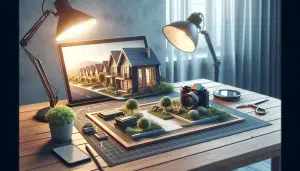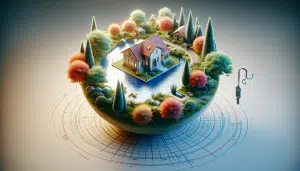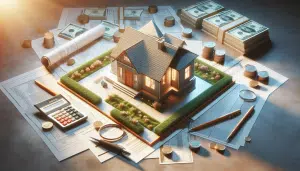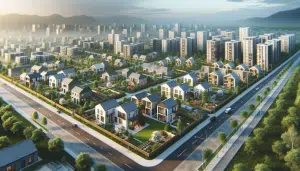Why Your Next Move Might Be a Green Home
Isabella Lewis October 21, 2025
Explore why energy-efficient homes are capturing attention in real estate. This guide unpacks the benefits of green housing, key features to look for, financial incentives, and how these eco-friendly properties could change how people think about homeownership.
Understanding Energy-Efficient Homes in Today’s Real Estate
Interest in energy-efficient homes is rising fast, as more buyers realize the positive impact these properties have on both utility bills and the environment. These homes blend advanced insulation, efficient appliances, and sustainable materials to create living spaces that require less energy for heating, cooling, and everyday living. In many markets, green homes have become a hallmark of desirable neighborhoods, drawing in buyers who want both comfort and long-term value.
Energy efficiency in real estate isn’t just a passing trend—it’s actively shaping what families and investors want. Features like smart thermostats, solar panels, double-glazed windows, and low-flow plumbing add appeal to modern homes. These features not only help reduce monthly costs but also add lasting value at resale. Some studies show green-certified properties can be valued higher than similar non-certified listings, making them a smart choice for long-term stability in home investments (https://www.energy.gov/energysaver/energy-saver).
With climate concerns growing, there’s also a growing sense of responsibility that influences buyer decisions. Eco-friendly homes allow residents to take direct action against carbon emissions. For many, choosing an energy-efficient property aligns personal values with practical benefits, such as improved indoor air quality and quieter living spaces. The benefits continue to unfold long after the move-in date, impacting daily comfort and overall cost of living.
Features That Make a Home Truly Energy Efficient
Several features separate energy-efficient properties from traditional construction. Perhaps most significant is advanced insulation—it keeps homes warmer in winter and cooler in summer, easing strain on heating and air conditioning systems. Triple-pane windows and tightly sealed doors further block drafts and energy loss, working together to cut utility expenses and maintain comfortable indoor temperatures throughout the year.
Modern green homes often leverage renewable energy sources, such as rooftop solar panels or ground-source heat pumps. These technologies enable households to generate or draw power sustainably, lowering reliance on fossil fuels. In some cases, excess electricity can even be fed back into the grid, creating the prospect of net-zero energy consumption. Over time, these savings can significantly offset the upfront investment of eco-friendly upgrades (https://www.epa.gov/greenhomes).
Other characteristics boost eco-housing value, such as energy-efficient lighting, ENERGY STAR-rated appliances, and water-saving fixtures. Low-VOC paints and sustainably sourced building materials enhance indoor air quality while minimizing environmental impact. Together, these details add up, making homes healthier to live in and more resilient to fluctuating energy prices.
The Benefits of Living in an Eco-Friendly Residence
Homeowners who choose green properties quickly notice meaningful changes. Lower energy bills are an obvious perk, but reduced environmental impact remains just as important to many residents. A more efficient home uses less energy for heating, cooling, lighting, and appliances—which means a smaller carbon footprint overall. This supports wider community goals for resource conservation and cleaner air.
Beyond energy savings, improved comfort and health are powerful incentives. Better insulation and enhanced indoor air quality, thanks to cleaner building materials and superior ventilation, create healthier spaces. Studies suggest children and adults in green-certified homes may experience fewer respiratory issues and feel more comfortable in every season (https://www.usgbc.org/articles/health-benefits-green-building).
Financially, eco-friendly homes hold their value remarkably well. As public demand grows, these properties appeal to future buyers, landlords, and renters. In some regions, owning a certified green home can result in favorable property taxes and easier access to mortgage programs focused on sustainability.
Financial Incentives and Support Available for Green Homeowners
Recognizing the public benefit of sustainable housing, many governments and agencies offer financial incentives to make the transition more manageable. Homebuyers may qualify for rebates, tax credits, or special loan programs that lower the upfront cost of energy-efficient features. These savings could take the form of direct rebates on solar installations, credits for using specific technologies, or deductions tied to upgrades like new windows or insulation (https://www.energy.gov/save-energy-money).
Green mortgage products are also gaining popularity. Lenders may offer favorable rates or higher borrowing limits when buyers choose homes that meet sustainability criteria. These programs reward investments in energy efficiency and can increase the pool of buyers who can afford a green home. For existing homeowners, low-interest loans can fund upgrades that reduce energy use—and sometimes, the loan payments are offset by future savings on utility bills.
In certain areas, utility providers partner with state and local programs to promote sustainable living. They might offer free or discounted energy audits, subsidized improvements, or even payment plans to help spread out costs. It’s always worthwhile to explore publicly available options and discover what’s available in your market. These programs continue to grow as the demand for energy-smart properties rises (https://www.dsireusa.org/).
What to Look For When Buying an Energy-Efficient Property
When exploring the green real estate space, look beyond the obvious. Accreditation matters. Search for properties with certification from programs such as ENERGY STAR, LEED, or the National Green Building Standard. These certifications signal that independent experts have verified the home’s energy performance, not just the builder’s claims, maximizing value and peace of mind for buyers (https://www.energystar.gov/newhomes).
Dig deeper into the features each home offers. Smart home technologies such as programmable thermostats, advanced lighting controls, and energy monitoring systems help manage consumption effectively. Well-insulated walls, ceilings, and foundations add to the efficiency and comfort. The construction age matters, but recent retrofits can make older homes just as competitive in performance as newer builds.
Assess long-term value, too. A house built with sustainability in mind often has lower maintenance requirements and can be easier to sell or rent out in the future. Be sure to review the utility bill history, ask about warranties on upgrades, and check whether the property is located near green community amenities such as bike paths or public transit. These details can make a significant difference in daily living and future costs.
How Green Building Impacts Property Value and the Broader Market
Growing evidence suggests that energy-efficient homes can command higher than average prices relative to conventional properties. Markets with a high concentration of green buildings often see a boost in neighborhood desirability, especially as more people prioritize sustainability. This trend encourages developers to build smarter, and communities to set new standards for growth and livability.
Some real estate professionals note that homes with environmental features tend to spend less time on the market. Enhanced demand from eco-conscious buyers, coupled with long-term utility savings, creates a win-win for both current owners and prospective buyers. The ripple effect? Lenders, insurers, and policymakers pay more attention—offering programs and incentives that weren’t widespread a decade ago (https://www.nar.realtor/research-and-statistics/research-reports/sustainability-report).
In the grand scheme, building and buying sustainably can inspire larger shifts toward carbon reduction and resource conservation. The rise of green housing influences zoning laws, encourages investment in renewable energy, and prompts new approaches to urban planning. As energy efficiency continues gaining ground, entire regions benefit from reduced pollution, lower utility loads, and healthier living environments.
References
1. U.S. Department of Energy. (n.d.). Energy Saver Guide. Retrieved from https://www.energy.gov/energysaver/energy-saver
2. U.S. Environmental Protection Agency. (n.d.). Green Homes. Retrieved from https://www.epa.gov/greenhomes
3. U.S. Green Building Council. (n.d.). Health Benefits of Green Building. Retrieved from https://www.usgbc.org/articles/health-benefits-green-building
4. U.S. Department of Energy. (n.d.). Save Energy, Save Money. Retrieved from https://www.energy.gov/save-energy-money
5. Database of State Incentives for Renewables & Efficiency. (n.d.). DSIRE. Retrieved from https://www.dsireusa.org/
6. National Association of Realtors. (n.d.). 2022 REALTORS® and Sustainability Report. Retrieved from https://www.nar.realtor/research-and-statistics/research-reports/sustainability-report







